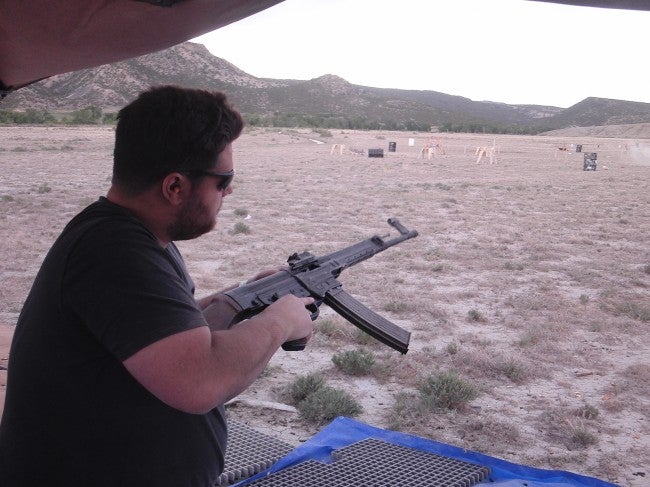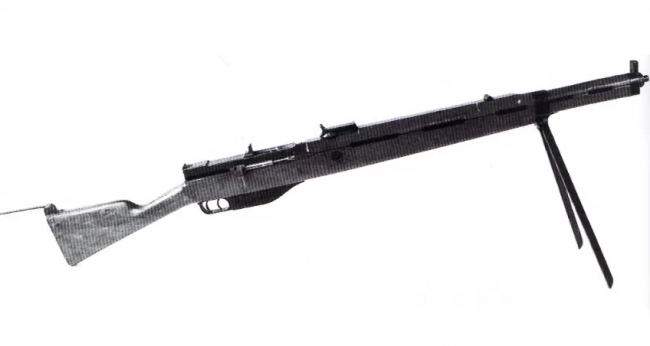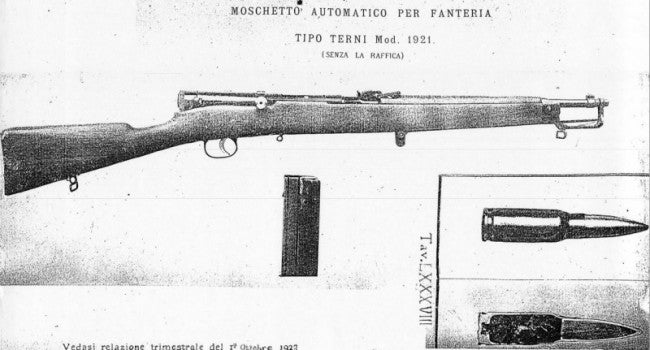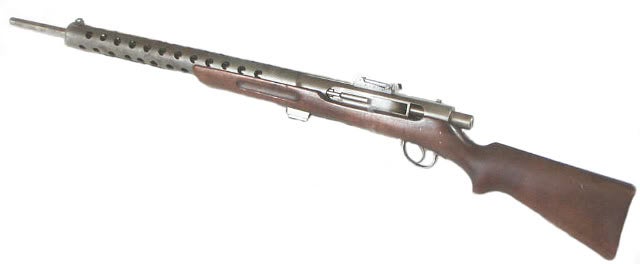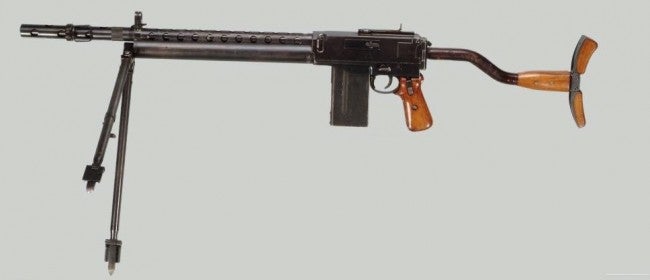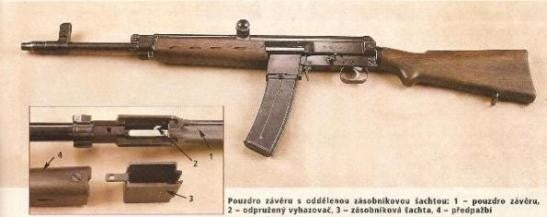The assault rifle is the defining individual weapon of warfare in the latter half of the 20th century, and the 21st. It’s history is deeply intertwined with the political and war-making developments of the era. Fast, mechanized maneuver warfare, the decline of cavalry, the continuing refinement of artillery, and perhaps most of all, the invention of the infantry mortar, meant that large formations of men firing powerful rifles at targets thousands of yards away dissolved, and were replaced by men with carbine-length bolt action rifles fighting through trenches, between bocages, and in jungles. Though by World War II trench warfare had faded from dominance, infantry were still expected to assault positions and fortifications, often more heavily defended than the trenches in the First World War were. This need, and the greatly reduced emphasis on long-range ballistics, formed the bedrock of requirements for what would later be called “assault rifles” in the West.
The weapon that lent its name to these rifles was the German Sturmgewehr, which was the first of its type to be issued in large numbers to the troops of any nation. However, it was not the first of its kind in the world. What follows is a collection of widely forgotten rifles that were important to the development of the late 20th Century’s primary individual weapon, though not all strictly qualify as “assault rifles” by all definitions. Some of the more well-known weapons (such as the BAR or Chauchat) have been left off this list for the sake of brevity, despite also being important milestones in the history of the modern assault rifle.
The Cei-Rigotti (Italy)
One of the earliest rifles that catches our attention is the Italian Cei-Rigotti of 1900, a very short, handy automatic weapon chambered for a rifle caliber. When this (rather obscure) rifle is discussed in literature, it is usually cited as being in Italian 6.5 Carcano caliber; however, all the examples known to the author are actually chambered in the 7.65mm Argentine caliber, making it a very powerful weapon in a full-size rifle caliber. Further, the rifle’s magazines were not quick-detachable, meaning it had to be reloaded via stripper clips. Because of its characteristics, it fails to meet some definitions of the term “assault rifle”, but it’s clear that it was designed to be a light, handy carbine, firing powerful rifle ammunition with an automatic fire mode. The Cei-Rigotti was a highly advanced design for 1900, featuring several elements that wouldn’t become common on rifles until half a century later. It was short-stroke gas piston operated, with a rotating bolt connected to the gas system by an operating rod on the right side (in a manner foreshadowing the Garand rifle). The bolt unlocked via a cam track in the bolt body into which a lug on the op rod fit, much like a Lewis Gun. While the action was based on that of the Carcano rifle, the Cei-Rigotti was a newly manufactured weapon, not a conversion of existing rifles.
The Rossignol ENT B1 (France)
Moving West from Italy, in France in the same year, the French undertook a modernization program to replace their bolt action Lebel rifles with self-loading weapons. One of these projects was the Rossignol ENT B1, a self-loading rifle in a very high velocity 6x60mm round with an automatic fire mode. Despite being select-fire, having a detachable box magazine, and arguably being chambered in an intermediate caliber, the ENT B1 weighed over twenty pounds, and was probably not very convenient for a normal infantryman to carry. The ENT B1 was a direct impingement gas-operated rotary bolt design, one of the first of its kind. Interestingly, the ENT B1 was intended to function as both an infantry rifle and a light machine gun, arguably making it one of the first “family of weapons” designs in military history. Not much else is known to the author about this rifle.
The Fedorov Avtomat (Russia)
One of the more well-known early developments is the Fedorov Avtomat rifle, designed by a Russian Imperial Army captain of the same name starting in 1906. The original experimental rifles were chambered in a cartridge of Captain Fedorov’s own design, a powerful 6.5x57mm caliber producing 3,140 J to 3,850 J (depending on the source). This cartridge was possibly too large for controllable automatic fire, but the Fedorov rifle was later redesigned in 1915 for the 6.5x51SR cartridge, which produced only 2,500 J, and the new rifles fed from detachable box magazines, not stripper clips like the older models. The Fedorov mechanism was recoil-operated, with a tilting locking block similar to that of the much later Vz. 58 rifle, but attached to the barrel instead of the bolt. Even if the initial concept fired full-power ammunition, the 1915 Fedorov Avtomat probably represents the first weapon in history to unambiguously qualify as an assault rifle. Some sources say Fedorov intended his rifle to be an individual weapon, but in service with the Russian Army, it was most often used as a light machine gun.
Winchester Model 1907 (Select-Fire) (USA/France)
About 2,500 Winchester Model 1907 selfloaders were ordered by the French Army during World War I as trench-clearing and aircraft guns. Many were modified at the Winchester factory with large-capacity magazines and select-fire capability. Fielded and used in combat in 1917-18, these modified Winchesters possibly represent the first assault rifles to enter service with any army (the Fedorov did not enter service with the Russian Army until 1918). The Winchester 1907 was a blowback rifle, firing powerful round-nosed .351 WSL ammunition, equivalent in energy to the later 7.62x39mm intermediate cartridge of the AK rifle.
Winchester Model 1917 Machine Rifle (USA)

The Winchester Model 1917 Machine Rifle and its pointed bullet loading of the .351 WSL cartridge. Image source: mpopenker.livejournal.com
The United States itself contributes to the story of very early assault rifles, too. The Winchester Model 1917 Machine Rifle was a curious internal development of the Winchester Repeating Arms Company, originally intended as an anti-observation balloon weapon. The rifle fired a rimless, modified version of the .351 WSL cartridge called .345 Winchester, with an incendiary spitzer projectile (for anti-balloon work), fed from twin 20 round magazines (emptying the right magazine first). Despite the odd intended purpose of the rifle, its utility as a close combat weapon was apparently quickly realized by its designers, as some examples were reportedly fitted with bayonet mounts. Firing the low-pressure .345 WSL cartridge meant the rifle could use the inexpensive and simple open bolt blowback system of operation, The rifle had many advanced features, such as a straight-line stock, raised sights, tubular construction, and a separate trigger module.
Ribeyrolle CM 1918 (France)
The French continued development of light, handy automatic weapons following their acquisition of Winchester 1907 self-loading rifles. The Ribeyrolle CM 1918 carbine fired an 8mm necked down variant of the .351 WSL cartridge, with the same 198gr spitzer bullet as the larger 8mm Lebel cartridge in service with the French Army at the time. There is not much data available pertaining to the Ribeyrolle “Mitrailleuse Carabine”, but it was fairly heavy, at 5.1kg (11.22lbs), and featured a bipod and bayonet mount. It was rejected in part for the weight, and in part for having poor accuracy beyond 400 meters. This insistence on maintaining good long-range performance would be a major institutional barrier to acceptance of the assault rifle idea in many countries, including the United States.
Modelo 1921 MAF (Italy)
Little information is available about this Italian carbine. The Moschetto Automatico per Fanteria Modelo 1921 was chambered for a 7.35mm or 7.65mm short cartridge firing a 135gr spitzer bullet at about 2,000 ft/s. The Italians, while recognizing the value of a short, controllable weapon with high ammunition capacity and good range, apparently seemed to be concerned with the consumption of ammunition, as the MAF did not have full auto capability. Later, the Italians would adopt a version of their bolt-action Carcano carbine as a standard infantry weapon, but chambered for a 7.35x51mm cartridge of very similar power to 7.62×39. It’s not hard to imagine that the Italians wanted their own automatic carbine, but did not feel that their logistics could keep up with thousands of troops blazing away on full automatic. Whether this reflects the designers’ actual intent, however, is unknown.
Furrer “Pistolengewehr” MP. 1920/1921 (Switzerland)
Resembling an over-grown World War I sub-machine gun, the Furrer “Pistolengewehr” was the work of Swiss engineer Adolf Furrer, the director of Waffenfabrik Bern. Like Furrer’s submachine guns, the Pistolengewehr was a toggle-action short-recoil operated weapon with a side-mounted 30 round magazine and conventional wood furniture. The initial 1920 model fired a 7.65x35mm cartridge based on a shortened 7.5×55 Swiss case which used a 123gr round-nosed bullet at a little over 2,000 ft/s, but the later 1921 model would use the same cartridge necked down to 7mm with a spitzer projectile. Some have suggested that Furrer’s research was used in Germany as the basis for their early select-fire intermediate caliber carbines, but this connection remains speculative.
Weibel/Danrif Rifle (Denmark)
Very little is known to the author about this 1932 Danish weapon. Even the name of the designer is uncertain, with some sources claiming it was a gentleman named Weibel, and some sources pertaining to the cartridge giving the name Danrif. It is known that it fired a 7x44mm cartridge with almost no case taper, with an 8 gram bullet and a muzzle velocity of 810 m/s. The rifle was apparently intended as a light machine gun to replace the Madsen, not as an individual weapon. This is similar to Finnish use of 7.62×25 sub-machine guns in the light machine gun role. Development ceased with the outbreak of war in 1939.
Korovin Avtomat (Russia)
Like the Weibel, there is scant information available about this Russian carbine from 1933. The 8.9mm nominal caliber and magwell size suggest it was chambered in the American .351 WSL caliber, though this is not known for certain.
Vollmer M35 (Germany)
Following a series of German self-loading rifles firing intermediate cartridges, from the Republican era and through Hitler’s rise to power, the Vollmer carbines began development in 1935. Firing a 7.75×40.5mm cartridge with a muzzle velocity of 705 m/s using a 9.5 gram bullet, it used a Bang-type gas trap gas system operating a rotary locking bolt, and firing from an open action. Development of the weapon continued until 1939 due to interest from the Heer and Luftwaffe, but was discontinued before the start of the Second World War.
ZK-412 (Czechoslovakia)
The most recent of all the weapons featured in this article, the ZK-412 rifle, also called the MK SS-42, was an independent Czechoslovakian project begun in 1939. The first prototypes were finished in either 1941 or 1942, depending on the source, just before the first German machine carbine prototypes were constructed. The weapon used a top-mounted fixed gas piston with nested recoil spring and under-hanging bolt carrier with a rotary bolt, very reminiscent of the later Kalashnikov rifle. It fired a round nosed 8 gram bullet at 670-720 m/s, and had the ability to penetrate a steel helmet at 600 meters. When in 1942, the German SS Führungshauptamt ordered Czechoslovakian designers to design a number of advanced weapons for the war effort, Skoda presented the already complete ZK-412 design. According to some sources, the weapon was trialled on the Eastern Front, and even captured, however this information cannot be confirmed by the author.
Closing Statement
The history of the assault rifle before the appearance of German automatic carbines on the World War II battlefield is colored by a dizzying array of concepts, features, and theories of operation. Perhaps this highlights the true significance of the Sturmgewehr – Germany during the Second World War did not invent the concept, nor were they the first to execute it or put it into practice, but the weapon their engineers created synthesized a number of concepts and design practices into one entity that heavily influenced virtually all weapons of its kind thereafter – and Adolf Hitler gave it a name that stuck.
Any errors or mistakes contained in this article are the fault of its author alone.
Works Cited:
- Hans-Dieter Handrich and R. Blake. Stevens, “Sturmgewehr!: From Firepower to Striking Power.”
- Gary Paul Johnston, Thomas B. Nelson, and Daniel D. Musgrave. “The World’s Assault Rifles.”
- Оружейная экзотика “Чешский автомат ZK-412. Чуть раньше “Штурмгевера”” http://raigap.livejournal.com/67917.html
- Guns.ru, “Шоша – жертва черного пиара?”, http://forum.guns.ru/forummessage/36/205475-3.html
- Defense and Freedom, “Interesting Hardware Stuff” http://defense-and-freedom.blogspot.com/2009/05/interesting-hardware-stuff.html
- Statens Forsvarhistoriske Museum, “7 x 44 automatgevær, Weibel M/1932” http://www.thm-online.dk/perioder/31/52/52-b5125/
- The Swiss Rifles Message Board, “Adolf Furrer’s 1921 assault rifle…”, http://theswissriflesdotcommessageboard.yuku.com/topic/3449#.UzoZR_ldXPA
- Max Popenker, “как много нам открытий чудных”, http://mpopenker.livejournal.com/1687654.html
- Max Popenker, “штурмгевер Бёртона”, http://mpopenker.livejournal.com/1242608.html
- Forgotten Weapons, “Cei-Rigotti”, http://www.forgottenweapons.com/early-semiauto-rifles/cei-rigotti/
- IAA Forum, “WRA Co .345 S.L. Brass”, http://iaaforum.org/forum3/viewtopic.php?f=8&t=14240&view=next
- IAA Forum, “Italian intermediate power cartridge, 1921?”, http://iaaforum.org/forum3/viewtopic.php?f=8&t=15378
- Anthony G. Williams, “Assault Rifles and Their Ammunition: History and Prospects”, http://www.quarry.nildram.co.uk/Assault.htm
- cartridgecollectors.org, “Cartridge of the Month October 2010”, http://cartridgecollectors.org/cmo/cmo10oct.htm
- municion.org, “Furrer 7.65×35”, http://municion.org/Swiss/765x38Furrer.htm
 Your Privacy Choices
Your Privacy Choices
